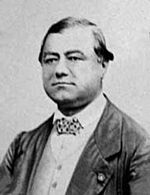Charles-Eugène Delaunay facts for kids
Quick facts for kids
Charles-Eugène Delaunay
|
|
|---|---|

Charles-Eugène Delaunay
|
|
| Born | 9 April 1816 |
| Died | 5 August 1872 (aged 56) Cherbourg, France
|
| Nationality | French |
| Known for | Delaunay variables |
| Scientific career | |
| Fields | Astronomy Celestial mechanics |
| Institutions | Paris Observatory |
Charles-Eugène Delaunay (born April 9, 1816 – died August 5, 1872) was a French astronomer and mathematician. He is famous for his important studies on how the Moon moves. His work helped improve our understanding of how planets move and also advanced mathematics.
Contents
About Charles-Eugène Delaunay
Charles-Eugène Delaunay was born in Lusigny-sur-Barse, France. He studied at the Sorbonne, a famous university in Paris. His teacher was Jean-Baptiste Biot.
Studying the Moon's Movement
Delaunay spent a lot of time studying the Moon's movement. He looked at it as a special part of the "three-body problem." This is a tricky challenge in science that tries to figure out how three objects in space move when they pull on each other with gravity.
He wrote two very long books about the Moon's movement. Each book was about 900 pages! These books were published in 1860 and 1867. His work showed how complicated the Moon's path can be. It also highlighted a problem in "perturbation theory." This theory uses math to predict how objects move when small forces (like gravity from other planets) affect them.
Even though his detailed math formulas for the Moon's position were hard to use in practice, they were very important. They helped scientists develop new ways of thinking about math, like "functional analysis" and "computer algebra." These ideas are now used in many areas of science and technology.
Later Life and Legacy
In 1870, Delaunay became the director of the Paris Observatory. This is a very important place for studying stars and planets. Sadly, he drowned in a boating accident near Cherbourg, France, just two years later.
Honours and Recognition
Charles-Eugène Delaunay received several important awards and recognitions for his work:
- He became a member of the Académie des Sciences (French Academy of Sciences) in 1855.
- He received the Gold Medal of the Royal Astronomical Society in 1870. This is a very high honour for astronomers.
- His name is one of the 72 names inscribed on the Eiffel Tower in Paris. This shows how important his contributions were to French science.
See also
 In Spanish: Charles-Eugène Delaunay para niños
In Spanish: Charles-Eugène Delaunay para niños

